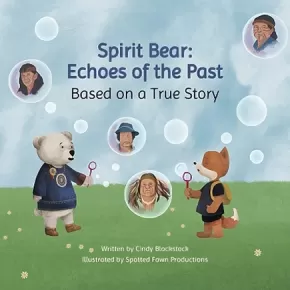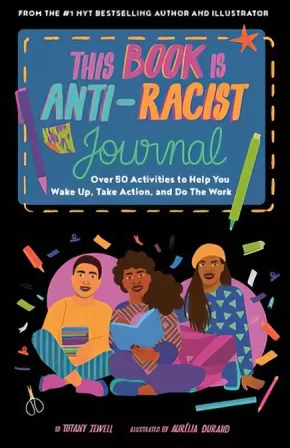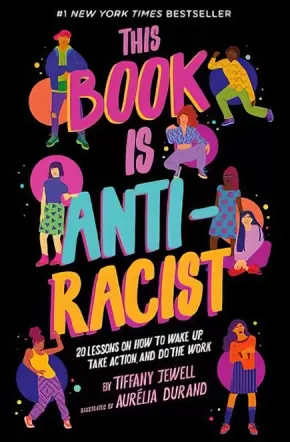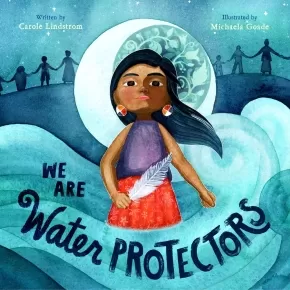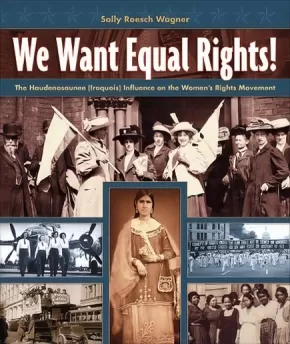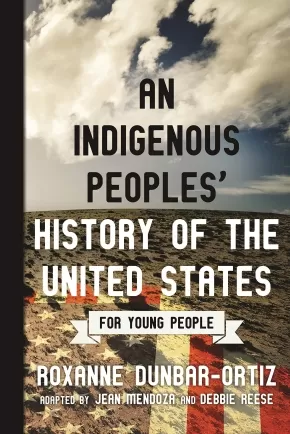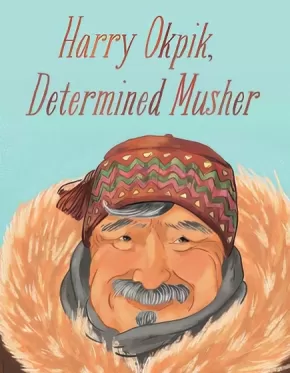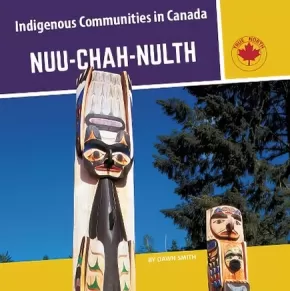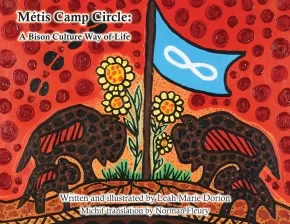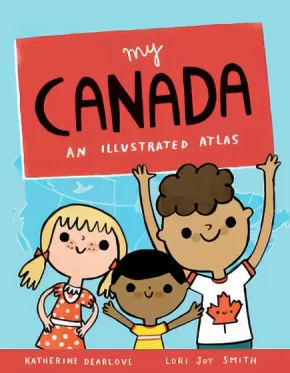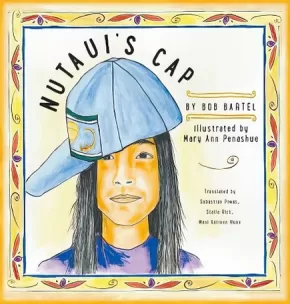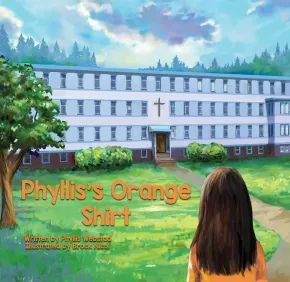
History
121
-
135
of
195 Results;
Sort By
Go To
of 13
Reflections from Them Days: A Residential School Memoir from Nunatsiavut
$12.95
Artists:
Editors:
Format:
Paperback
Text Content Territories:
Indigenous Canadian; Inuit;
ISBN / Barcode: 9781774502075
Synopsis:
Synopsis:
When Nellie Winters was 11 years old, she was sent to attend the Nain Boarding School, a residential school 400 kilometres from her home. In this memoir, she recalls life before residential school, her experiences at the school, and what it was like to come home.
Accompanied by the author’s original illustrations, this moving, often funny memoir sheds light on the experiences of Inuit residential school survivors in Labrador.
Educator & Series Information
Recommended for ages 11-14.
This book is recommended in the Canadian Indigenous Books for Schools 2020/2021 resource list for grades 5 to 7 for English Language Arts and Social Studies.
This book is part of the Qinuisaarniq (“resiliency”) program. This is a program created to educate Nunavummiut about the history and impacts of residential schools, policies of assimilation, and other colonial acts that have affected the Canadian Arctic.
Each resource has been carefully written and reviewed to include level-appropriate opportunities for students to learn about colonial acts and policies that have affected Inuit. These acts and policies created long-lasting impacts on Inuit individuals and communities, which are still being felt today.
The resources in this program include personal interviews, testimony, and writing; non-fiction informational resources; and information about traditional Inuit practices.
Additional Information
26 pages | 9.00" x 7.00" | Transcribed and edited by Erica Oberndorfer
Spirit Bear: Echoes of the Past: Based on a True Story
$12.95
Artists:
Format:
Paperback
Text Content Territories:
Indigenous Canadian; First Nations;
ISBN / Barcode: 9781777009137
Synopsis:
Synopsis:
For the past 13 years, Spirit Bear has been working hard to make sure First Nations children get the help they need when they need it so they can grow up safely with their families, get a good education, and be healthy and proud of who they are.
It's been a long journey, and Spirit Bear needs a vacation! He and his family set out for Songhees and Esquimalt territories (Victoria, British Columbia) for their holiday adventure. Along the way, they see a statue of John A. Macdonald - Canada's first Prime Minister - being removed from the steps of Victoria City Hall. Some people have signs that say, "Save the statue," and others have signs that say, "The statue must go!" Spirit Bear and his family learn why people disagree and how we can learn from the good and bad parts of history to make better decisions now and for future generations of First Nations, Métis, and Inuit kids.
Educator & Series Information
Recommended for ages 6 to 12.
This book is part of the Spirit Bear series.
This book is available in French: Spirit Bear: echos du passe: Base sur une histoire vraie
Additional Information
51 pages | 8.25" x 8.25"
This Book Is Anti-Racist Journal: Over 50 Activities to Help You Wake Up, Take Action, and Do The Work
$16.99
Artists:
Format:
Paperback
ISBN / Barcode: 9780711263031
Synopsis:
Synopsis:
An official companion to the #1 New York Times bestseller, this guided journal contains more than 50 activities to support your anti-racism journey.
In This Book Is Anti-Racist, Tiffany Jewell and Aurélia Durand gave us an essential volume to understand anti-racism. Now, in the journal companion, understand your anti-racist self and dive further into the work. Within the vibrantly illustrated pages, you will find some familiar information along with new reflections and prompts to go deeper.
This anti-racist toolkit gives you space to learn and grow through activities centered around identity, history, family, your universe, disruption, self-care, privilege, art, expression, and much more, including:
- Create a map of you by drawing, collaging, sticking, and painting your many and favorite social and personal identities
- Discover how diverse your universe is by writing down the races and ethnicities of the people in your life
- Design your own buttons that share your beliefs, values, and what you stand for
- Write a letter to your future self to share your dreams and how you are growing into your anti-racism
- Make a plan and be ready for scenarios when you are confronted by racist comments, actions, and policies
- Brainstorm your anti-racist vision of what our communities will look like without racism and how we can get there
“Continue to stay awake, start taking action, and always lean into the work of disrupting racism. Together, we can abolish the system that continues to misuse and abuse power and collectively work for anti-racism.” —Tiffany Jewell
Reviews
"This journal gives children (and adults) tools to learn about identity, privilege, history, family, and much more. Through a range of activities, you can plan for future scenarios where you may come across racism and how you will handle it. A brilliant book for older children, teenagers and adults, it would be great for use in schools too!”—Diverse Kids Books Blog
Educator Information
Recommended for ages 11 to 15.
Find the accompanying resource here: This Book Is Anti-Racist: 20 Lessons on How to Wake Up, Take Action, and Do the Work
Additional Information
96 pages | 5.60" x 8.55" | Paperback
This Book Is Anti-Racist: 20 Lessons on How to Wake Up, Take Action, and Do the Work
$19.99
Artists:
Format:
Paperback
Text Content Territories:
Indigenous American;
ISBN / Barcode: 9780711245211
Synopsis:
Synopsis:
Who are you? What is racism? Where does it come from? Why does it exist? What can you do to disrupt it? Learn about social identities, the history of racism and resistance against it, and how you can use your anti-racist lens and voice to move the world toward equity and liberation.
“In a racist society, it’s not enough to be non-racist—we must be ANTI-RACIST.” —Angela Davis
Gain a deeper understanding of your anti-racist self as you progress through 20 chapters that spark introspection, reveal the origins of racism that we are still experiencing, and give you the courage and power to undo it. Each lesson builds on the previous one as you learn more about yourself and racial oppression. An activity at the end of every chapter gets you thinking and helps you grow with the knowledge. All you need is a pen and paper.
Author Tiffany Jewell, an anti-bias, anti-racist educator and activist, builds solidarity beginning with the language she chooses—using gender neutral words to honor everyone who reads the book. Illustrator Aurélia Durand brings the stories and characters to life with kaleidoscopic vibrancy.
After examining the concepts of social identity, race, ethnicity, and racism, learn about some of the ways people of different races have been oppressed, from Indigenous Americans and Australians being sent to boarding school to be “civilized” to a generation of Caribbean immigrants once welcomed to the UK being threatened with deportation by strict immigration laws.
Find hope in stories of strength, love, joy, and revolution that are part of our history, too, with such figures as the former slave Toussaint Louverture, who led a rebellion against white planters that eventually led to Haiti’s independence, and Yuri Kochiyama, who, after spending time in an internment camp for Japanese Americans during WWII, dedicated her life to supporting political prisoners and advocating reparations for those wrongfully interned.
Learn language and phrases to interrupt and disrupt racism. So, when you hear a microaggression or racial slur, you'll know how to act next time.
This book is written for EVERYONE who lives in this racialized society—including the young person who doesn’t know how to speak up to the racist adults in their life, the kid who has lost themself at times trying to fit into the dominant culture, the children who have been harmed (physically and emotionally) because no one stood up for them or they couldn’t stand up for themselves, and also for their families, teachers, and administrators.
With this book, be empowered to actively defy racism and xenophobia to create a community (large and small) that truly honors everyone.
Educator Information
Recommended for ages 11 to 15.
Some, but limited, Indigenous content.
A journal filled with activities is also available: This Book Is Anti-Racist Journal: Over 50 Activities to Help You Wake Up, Take Action, and Do The Work
Additional Information
160 pages | 5.15" x 7.75" | Colour Illustrations | Paperback
We Are Water Protectors
$24.99
Artists:
Format:
Hardcover
Text Content Territories:
Indigenous Canadian; First Nations; Anishinaabeg; Indigenous American; Native American; Anishinaabeg;
ISBN / Barcode: 9781250203557
Synopsis:
Synopsis:
Inspired by the many Indigenous-led movements across North America, Carole Lindstrom's bold and lyrical picture book We Are Water Protectors issues an urgent rallying cry to safeguarding the Earth’s water from harm and corruption.
Water is the first medicine.
It affects and connects us all . . .
When a black snake threatens to destroy the Earth and poison her people’s water, one young water protector takes a stand to defend Earth’s most sacred resource.
Featuring illustrations by Michaela Goade.
Educator Information
Recommended for ages 3 to 6.
Includes information on water protectors and the importance of water protection at the back of the book, as well as a glossary with a few words in different Indigenous languages, such as Ojibwe, Tlingit, and Lakota.
This book is available in French: Nous sommes les protecteurs de l'eau
Additional Information
40 pages | 10.00" x 10.00"
We Want Equal Rights!: How Suffragists Were Influenced by Haudenosaunee Women
$18.95
Format:
Paperback
Text Content Territories:
Indigenous American; Native American; Haudenosaunee (Iroquois);
ISBN / Barcode: 9781939053282
Synopsis:
Synopsis:
This is the story of remarkable women who laid the foundation for the modern women's movement and the Native American nation that proved equality was possible. In 1850, these brave women challenged a culture that believed they were inferior to men. How did they envision such a world? They looked to their neighbors the Haudenosaunee (Iroquois) and saw how women were held in high regard, with even greater rights than men. In the United States, a woman was considered subservient to her husband, who gained all his wife's wealth upon marriage. Women had no claim to their children and were considered runaway slaves if they left an abusive man. In contrast Haudenosaunee society provided a shining example of what is possible when women are treated with respect. Read how early activists forged a path to women's equal rights using the ideals of their Native American neighbors.
Educator Information
Recommended for ages 9 to 12.
This work is from an American publisher. Therefore, terminology may be different than what is used in Canada.
Subjects / Concepts: Human Rights, Women's Rights, Native American, Indigenous, History, Biographies, Social Activists.
Additional Information
48 pages | 7.90" x 9.40" | Paperback
An Indigenous Peoples' History of the United States for Young People
$24.95
Format:
Paperback
Text Content Territories:
Indigenous American; Native American;
ISBN / Barcode: 9780807049396
Synopsis:
Synopsis:
Spanning more than 400 years, this classic bottom-up history examines the legacy of Indigenous peoples’ resistance, resilience, and steadfast fight against imperialism.
Going beyond the story of America as a country “discovered” by a few brave men in the “New World,” Indigenous human rights advocate Roxanne Dunbar-Ortiz reveals the roles that settler colonialism and policies of American Indian genocide played in forming our national identity.
The original academic text is fully adapted by renowned curriculum experts Debbie Reese and Jean Mendoza, for middle-grade and young adult readers to include discussion topics, archival images, original maps, recommendations for further reading, and other materials to encourage students, teachers, and general readers to think critically about their own place in history.
Reviews
“An important corrective to conventional narratives of our nation’s history . . . . An accessible, engaging, and necessary addition to school libraries and classrooms. An excellent read, dismantling American mythologies and fostering critical reasoning about history and current events.” —Kirkus Reviews, Starred Review
“This adaptation of An Indigenous Peoples’ History of the United States (2014) should be required reading for all middle and high schoolers—and their teachers . . . . There is much to commend here: the lack of sugar-coating, the debunking of origin stories, the linking between ideology and actions, the well-placed connections between events past and present, the quotes from British colonizers and American presidents that leave no doubt as to their violent intentions . . . . The resistance continues, and this book urges all readers to consider their own roles, whether as bystanders or upstanders.” —Booklist, Starred Review
“Dunbar-Ortiz’s narrative history is clear, and the adapters give readers ample evidence and perspective to help them to engage with the text. A highly informative book for libraries serving high school students.”—School Library Journal, Starred Review
“This is the book I wish I’d had when I started teaching. An Indigenous Peoples’ History of the United States for Young People represents a fundamental challenge to the textbooks that celebrate ‘liberty,’ ‘freedom,’ and the ‘rise of the American nation’ but fail to recognize the humanity—or often even the existence—of the Indigenous peoples who were here first, and are still here. Our students will see the history of this country much more clearly when we put Indigenous people’s lives at the center.” —Bill Bigelow, curriculum editor, Rethinking Schools, and codirector, Zinn Education Project
Educator Information
Recommended for ages 12+
Additional Information
272 pages | 5.49" x 7.97"
Celebrations in Nunavut - Nunavummi Reading Series
$8.95
Artists:
Format:
Paperback
Text Content Territories:
Indigenous Canadian; Inuit;
ISBN / Barcode: 9780228702757
Synopsis:
Synopsis:
In Nunavut, there are a lot of things to celebrate!
This book features celebrations that are important to communities across the North, such as The Return of the Sun and Nunavut Day.
Educator & Series Information
This book is part of the Nunavummi Reading Series, a Nunavut-developed series that supports literacy learning while teaching readers about the people, traditions, and environment of the Canadian Arctic. It is a Level 10 book in the series.
Nunavummi Reading Series books have also been officially levelled using the Fountas & Pinnell Text Level Gradient™ Levelling System. F&P Level of this book: L.
Curriculum Connections: Language and Literacy; Diversity; Indigenous Perspectives; History and Heritage.
Recommended for ages 6 to 8.
Additional Information
22 pages | 7.00" x 9.00"
Harry Okpik, Determined Musher - Nunavummi Reading Series
$16.95
Artists:
Format:
Hardcover
Text Content Territories:
Indigenous Canadian; Inuit;
ISBN / Barcode: 9781772665758
Synopsis:
Synopsis:
Meet a real-life Inuit hero!
This book introduces the biography genre while teaching children about the life of Harry Okpik and the history of dogsledding.
Educator & Series Information
This book is part of the Nunavummi Reading Series, a Nunavut-developed series that supports literacy learning while teaching readers about the people, traditions, and environment of the Canadian Arctic. It is a Level 13 book in the series.
Nunavummi Reading Series books have also been officially levelled using the Fountas & Pinnell Text Level Gradient™ Levelling System. F&P Level of this book: N.
Curriculum Connections: Language and Literacy; Diversity; Indigenous Perspectives; Identity; Self-Image
Recommended for ages 7 to 9.
Additional Information
52 pages | 7.50" x 9.30"
Indigenous Communities in Canada: Nuu-Chah-Nulth
$14.95
Format:
Paperback
Text Content Territories:
Indigenous Canadian; First Nations; Nuu-chah-nulth (Nootka);
ISBN / Barcode: 9781773086392
Synopsis:
Synopsis:
This book explores the Nuu-Chah-Nulth.
Educator & Series Information
This book is part of the Indigenous Communities in Canada series.
Additional Information
24 Pages
Inuit Games - Nunavummi Reading Series
$18.95
Artists:
Format:
Hardcover
Text Content Territories:
Indigenous Canadian; Inuit;
ISBN / Barcode: 9780228702870
Synopsis:
Synopsis:
Inuit games have been played as long as anyone can remember!
Learn all about Inuit games and why they are important for staying healthy and strong for life in the Arctic.
Educator & Series Information
This book is part of the Nunavummi Reading Series, a Nunavut-developed series that supports literacy learning while teaching readers about the people, traditions, and environment of the Canadian Arctic. It is a Level 11 book in the series.
Nunavummi Reading Series books have also been officially levelled using the Fountas & Pinnell Text Level Gradient™ Levelling System. F&P Level of this book: L.
Curriculum Connections: Language and Literacy; Diversity; Indigenous Perspectives; History and Heritage.
Recommended for ages 6 to 8.
Additional Information
24 pages | 10.30" x 8.50"
Métis Camp Circle: A Bison Culture Way of Life
$17.50
Artists:
Text Content Territories:
Indigenous Canadian; Métis;
ISBN / Barcode: 9781926795959
Synopsis:
Synopsis:
During much of the nineteenth century, bison hunting was integral to the Métis’ social, economic, and political life. As “people of the buffalo,” the Métis were bison hunters par excellence. In Métis Camp Circle: A Bison Way of Life, author and artist Leah Marie Dorion transports young readers back in time when bison were the basis of Métis lifeways on the Plains. Vibrantly illustrated and infused with important cultural teachings, this charming book skillfully informs us about this important period of Métis history.
Educator Information
Grade Level: Primary (recommended by Gabriel Dumont Institute).
Dual-language: English and Michif. Includes a CD with English and Michif narration.
Includes back matter on Bison as a Food Source; Organizing the Bison Hunt; Bison Artefacts; Pemmican; Patrice Fleury Remembrance (on the bison hunt); and more information about the author/illustrator and translator.
Additional Information
43 pages
My Canada: An Illustrated Atlas
$9.95
Artists:
Format:
Paperback
ISBN / Barcode: 9781771473774
Synopsis:
Synopsis:
This picture book atlas of Canada is a whimsical, informative introduction to our country from sea to sea to sea. Each province and territory is featured on its own spread, with icons and labels indicating the capital city, other major cities, key lakes and rivers, iconic landmarks, animals, and plants, significant national and provincial parks, and more.
Each map is lively and colorful with plenty of details to discover. Simple labels make key places and landmarks easily searchable for further research. Inspired by the illustrator’s map of PEI, a longtime gift shop bestseller, My Canada includes basic information about Canada and a full map of the country.
Reviews
"Sure to send adventure-bound readers digging to find out more about the features labelled in this atlas." — Quill & Quire
"One of the simplest yet most clear and complete picture book atlases I have ever seen...a wonderful resource for classroom and public libraries. Highly Recommended." — Canadian Review of Materials
"This informative trip across Canada celebrates its people, places, and landscapes--and invites further exploration. A fine addition to geography collections."— School Library Journal
"My Canada is a joyful depiction of our home and native land - a wonderful way to introduce geography and maps to youngsters."— Canadian Children’s Book News
"This book would be good as an introduction to maps and how they depict various areas." — Resource Links
Educator Information
Recommended Ages: 4-8
Reading Levels: Pre-K to Grade 2
Curriculum Connections: Social Studies - Canadian Heritage and History; Geography - Canadian Geography, Maps.
Additional Information
32 pages | 11.00" x 8.50"
Nutaui's Cap
$22.95
Artists:
Format:
Hardcover
Text Content Territories:
Indigenous Canadian; First Nations; Innu (Montagnais-Naskapi); Sheshatshiu Innu;
ISBN / Barcode: 9781927917244
Synopsis:
Synopsis:
Without warning, a deafening boom drove us to the ground, even Nutaui. I heard my heart pound hard against my chest. Seconds later another earsplitting blast struck us.
A moving story of protest and determination, Nutaui's Cap tells of a young Innu girl, Nanas. The low-level flying of NATO supersonic jets disrupts her family's traditional way of life, and endangers both them and the wildlife they depend upon, so Nanas' father and the other members of the Sheshatshiu community decide to protest by occupying the military's runways. Nanas is proud and eager to join in the social action, but then her father is arrested. Nanas has little to comfort her except his well-worn ball cap, and the promise of the land itself that the resilience, wisdom, and strength of the Innu people will one day triumph.
This true account of one small moment in the years-long struggle of the Innu people against NATO and the Canadian government brings to light the on-going fight for Innu rights on their own unceded land. Author Bob Bartel, an activist and volunteer, participated in the efforts to stop those NATO practice flights; he learned Nanas's story from her aunt and has Nanas's permission to tell the story. Bartel writes with care, simplicity, and deep awareness; he portrays with both power and subtlety the struggle as seen from a child's perspective.
Illustrations by acclaimed Innu artist Mary Ann Penashue capture the gentle relationship between Nanas and her father, and highlight the beauty and dignity of her people's culture. Her blending of traditional imagery with modern technique offers a visually rich and compelling accompaniment to Bartel's text.
Educator Information
Compelling story about Innu protests as seen from the perspective of child.
Author Bob Bartel, an activist and volunteer, participated in the efforts to stop those NATO practice flights; he learned Nanas's story from her aunt and has Nanas's permission to tell the story.
Nutaui's Cap has been translated into two dialects of Innu-aimun, both of which appear alongside the English. Some Innu-aimun words are also integrated into the English text; a glossary is provided. A map of the locations and a historical afterword, offering further context, are included as well.
Translated by Stella Rich, Sebastian Piwas, and Mani Katinen Nuna, with Laurel Anne Hasler, Penash Rich, and Marguerite MacKenzie
This book is a co-publication with Mamu Tshishkutamashutau Innu Education.
Recommended for ages 6 to 12.
Additional Information
68 pages | 9.00" x 9.00"
Phyllis's Orange Shirt
$11.95
Artists:
Format:
Hardcover
Text Content Territories:
Indigenous Canadian; First Nations; Salish; Interior Salish; Secwepemc (Shuswap); Stswecem'c Xgat'tem;
ISBN / Barcode: 9781989122242
Synopsis:
Synopsis:
When Phyllis was a little girl she was excited to go to residential school for the first time. Her Granny bought her a bright orange shirt that she loved and she wore it to school for her first day. When she arrived at school her bright orange shirt was taken away. This is both Phyllis Webstad's true story and the story behind Orange Shirt Day which is a day for us all to reflect upon the treatment of First Nations people and the message that 'Every Child Matters'.
Educator Information
Phyllis's Orange Shirt is an adaptation of The Orange Shirt Story which was the best selling children's book in Canada for several weeks in September 2018. This true story also inspired the movement of Orange Shirt Day which could become a federal statutory holiday. A page of information about this day is included at the end of the book. A short author biography is also included.
Adapted for ages 4-6.
Recommended in the Canadian Indigenous Books for Schools 2020/2021 resource list for grades K-1 in the areas of English Language Arts and Social Studies.
This book is available in French: Le chandail orange de Phyllis
Additional Information
30 pages | 9.00" x 8.00"
Sort By
Go To
of 13




